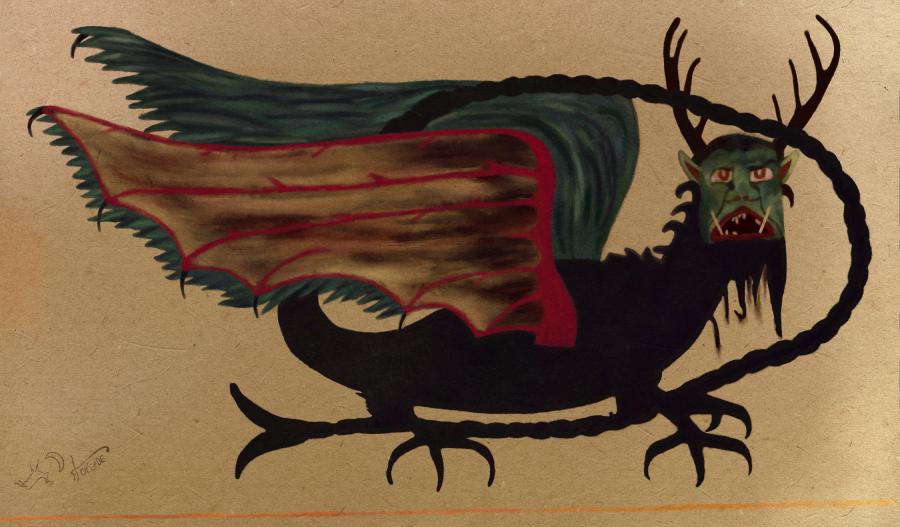When You're Distracted by the Erasure of a People's Origin Story from the Annals of History
The section on American dragons as it presently sits (worth it for the latest pronounciation gimic alone (which I am, admittedly, beating to death … we'll see how many manage to remain)) …
Dragons flourished all across the pre-Columbian Americas; however, getting to know them is a f$&king challenge. Genocide and forced assimilation kinda tend to disappear the afflicted culture. Consider the case of the Piasa Bird found in Alton, Illinois.

A pair of these suckers were absof$&kinlutely painted upon the limestone bluffs above the confluence of the Illinois and Mississippi rivers. How do we know? A Frenchman told us what he saw during his 1673 expedition of the Mississippi River. As to what he said, here's the valuable bit:
They are as large as a calf; they have horns on their heads like those of deer, a horrible look, red eyes, a beard like a tiger's, a face somewhat like a man's, a body covered with scales, and so long a tail that it winds all around the body, passing above the head and going back between the legs, ending in a fish's tail. Green, red, and black are the three colors composing the picture.
The 1917 publication from which I've pulled his account also includes a helpful little footnote. See if you can spot the problem:
These pictographs on a rock near Alton, Illinois, were called "piasa" and supposed to represent the "thunder bird." They were quite distinct when described by Stoddard in 1803; when visited in 1838 only one could be seen, of which truces were discernible as late as 1848, soon after which the rock was quarried down.
I mean…
🄐 The account from 1673 doesn't say sh$t about what these things are called.
⑵ The footnote from the publication doesn't say sh$t about who mentioned the things oughta be called piasa.
(⠼⠉) They quarried … the fucking … rock.
Before moving on from Marquette's account, I wanna show you the least valuable bit. Picking up where we left off in that first quote:
Moreover, these two monsters are so well painted that we cannot believe that any savage is their author; for good painters in France would find it difficult to paint so well, and besides, they are so high up on the rock that it is difficult to reach that place conveniently to paint them.
I believe the Illini response to this was something like ᐃᒃᓯᕚᕐᓂᖅ ᕿᒥᕐᓗ (pronounced sit and spin).
It gets better.
The painting I recreated is by Herbert Forcade. He made it in preparation for painting the f$&ker back up on that limestone bluff. In 1924, he totally did. In the 1960s, they totally blasted that shit to make way for the Great River Road.
Curious how the Piasa Bird got its name? Let me tell you. In 1836, local Professor John Russell of Shurtleff College published an article with the deets he claims to have obtained from the Illini. Of the stream below the bluff, he has this to say:
This "stream is the Piasa. Its name is Indian, and signifies, in the Illini, 'The bird which devours men.' Near the mouth of this stream, on the smooth and perpendicular face of the bluff, at an elevation which no human can reach, is cut the figure of an enormous bird, with its wings extended. The animal which the figure represents was called by the Indians the Piasa. From this is derived the name of the stream.
Okay, so far, we have a real portrayal of a Native American dragon … given to us by a small-minded Frenchman. We add to this the naming of the thing some one hundred sixty-three years later by a professor from a Baptist college (further confirmed in the footnotes of a book published some seventy-six years after the prof's article). What we seem to be missing is some authentic Illini legend of this creature. Have we one of those?
As it happens, we do have one of those, provided in the very same article that gave us the beast's name. Search the internet for the bird's backstory, and you'll find the Legend of the Piasa Bird repeated in countless places. Why haven't I told you the legend? 'Cause the f$&ker admitted he made the whole g0dd@mn thing up. You've got about a 50/50 shot of being told that alongside any given one of those repetitions.
Finding myself discontent with this as the only dragon from the Americas, I think I'll paint a couple more for y'all to meet before the exhibition closes.